No Change in Land Values For 2020
TOPICS
Land Value
photo credit: Kyle L. Wilson, Used with Permission
John Newton, Ph.D.
Chief Economist
The average value of agricultural cropland is $4,100 per acre in 2020, unchanged from 2019 but in line with the record highs seen in 2019 and 2015, according to USDA’s recently released 2020 Land Values report. Similarly, the average value of cropland, including all land and buildings on farms, was $3,160 per acre for 2020, unchanged from 2019’s record high. The average value for pastureland was $1,400 per acre for 2020, again unchanged from 2019. Cash rental rates for cropland averaged $139 per acre in 2020, down $1 per acre from 2019.
The stability in agricultural land values and cash rents occurs amid continued pressure on farm income and commodity prices. This stability is likely a result of low interest rates (the 10-year Treasury is less than 1%), a low turnover ratio for agricultural cropland and a competitive cash rent market for farmers seeking to capture economies of scale. Importantly, the cash rental rates were negotiated prior to the impact of COVID-19 on crop prices. Figure 1 highlights the average cropland and cash rental rate values.

State-Level Agricultural Land Values
Agricultural land values were the highest in the Northeastern states, with densely populated urban areas such as Rhode Island, New Jersey, Connecticut and Massachusetts representing four out of the top five states in terms of average agricultural land values. California rounds out the top five. Outside of urban areas, agricultural land values were highest through the Corn Belt, the Great Lakes region, the Southeast and the Pacific Northwest. Through the Corn Belt, agricultural land values were the highest in Illinois at $7,400 per acre, followed by Iowa at nearly $7,100 per acre. Western states with both a higher concentration of livestock feeding operations and a high percentage of pastureland had lower average agricultural land values. Figure 2 highlights the average agricultural land value per acre in 2020.
While average U.S. agricultural land values were unchanged from 2019, several states had increases. Idaho had the largest percentage increase in agricultural land values in 2020, jumping nearly 4% from 2019. Rhode Island’s agricultural land values rose to $16,000 per acre, up $400 per acre, or 3%, from 2019. Kansas and New York had the sharpest declines in agricultural land values, down 3.1% each from 2019. Across the Corn Belt, agricultural land values in Iowa dropped 1.7%, or $120 per acre, while South Dakota experienced a 2.9% decline. Other Corn Belt states, such as Illinois, Ohio and Indiana, had higher agricultural land values – potentially due to the larger urban areas. Figure 3 identifies the year-over-year change in agricultural land values.


Cash Rental Rates
In addition to owning agricultural land, many farm operators also rent cropland. Rental agreements are generally made in the fall of the prior year, e.g., 2020 rental rates were agreed to in the fall of 2019. At the latest, they’d be made prior to planting. For 2020, USDA’s state-level estimates of cash rents for cropland reveal a U.S. average rental rate of $139 per acre, down $1 per acre, or 0.7%, from 2019. This is the first national average decline in cash rental rates since 2015, when the national average cash rental rate dropped $8 per acre.
For highly productive and mostly non-irrigated cropland, cash rental rates were the highest in Iowa at $230 per acre, followed by Illinois at $222 per acre. In areas with high levels of irrigation and specialty crop production, cash rental rates were the highest in California at $439 per acre followed by Arizona at $275 per acre. Figure 4 highlights the cash rental rates for cropland.
While national average cash rents were down only slightly from 2019, several states had more significant year-over-year variations. Nevada’s cash rental rates dropped by $57 per acre, a 35% decline -- the sharpest in the U.S. Other Western states, such as Wyoming, Colorado and New Mexico, also had double-digit percentage changes in cash rental rates. Florida experienced a 20% increase in rental rates, followed by Utah at 11%.
In Corn Belt and Midwestern states, cash rental rates were mostly flat. Cash rental rates in Iowa, Indiana, Minnesota and Missouri were unchanged from 2019, while Illinois experienced a 0.9% decline. South and North Dakota, Kansas, Nebraska, Wisconsin and Michigan all had slightly higher cash rental rates in 2020. Figure 5 identifies the year-over-year change in cash rental rates.


Summary
For years, in the face of a down farm economy and low commodity prices, many had expected to see some downward pressure on land values and cash rental rates. We now know that’s not been the case. Low interest rates continue to make agricultural land an attractive investment. In addition to low interest rates, and a low turnover of agricultural land, individuals, large-scale investors, estates, trusts and other institutional owners continue to invest in farmland.
Other factors likely bolstering land values and cash rents are Market Facilitation Program payments, designed to help farmers recover from retaliatory tariffs, and ad hoc disaster aid to help producers impacted by wildfires, hurricanes and flooding in recent years. Farmers receiving this aid are more likely to hold onto cash rental agreements.
The relief provided to agricultural producers impacted by COVID-19 will likely contribute to stability in land prices into 2021. Beyond 2021, and as long as COVID-19 continues to impact demand, without additional support to producers, outside of low interest rates, there will be less to support cash rents (and potentially agricultural land values) at these lofty levels.